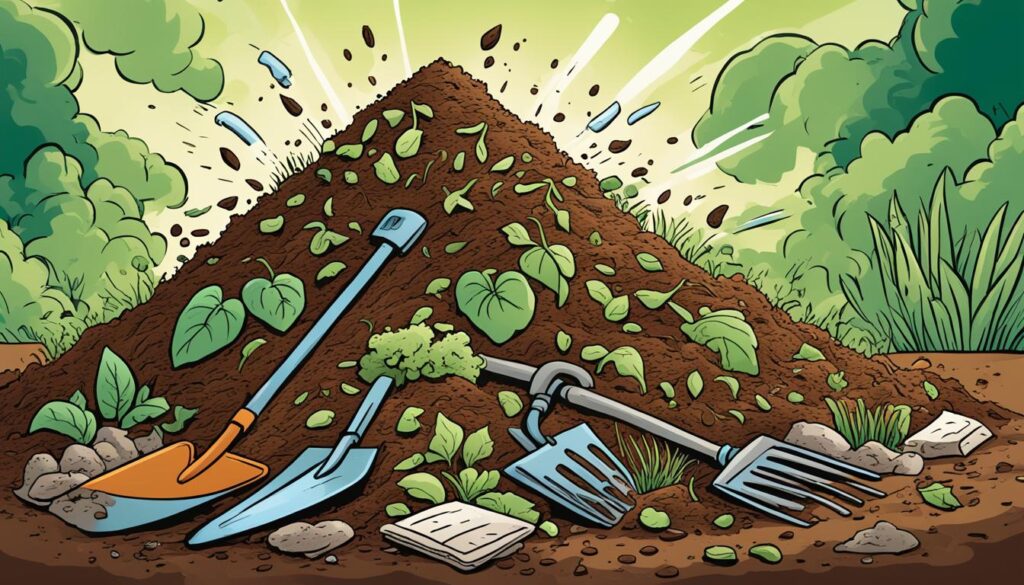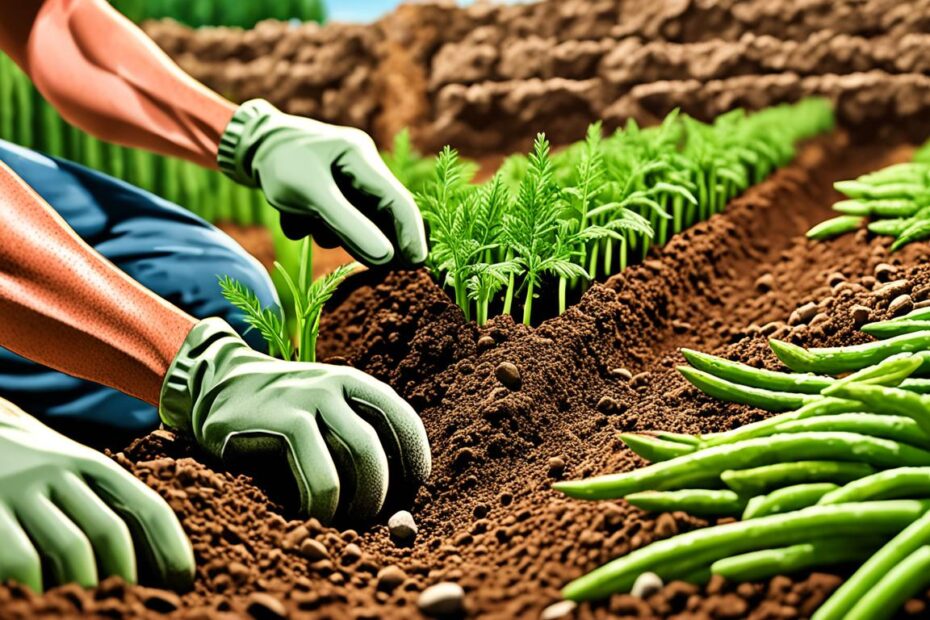Are you ready to elevate your gardening skills and cultivate delicious, homegrown asparagus? The secret to a thriving asparagus patch lies in one crucial step: preparing the soil. But what exactly does it take to create the perfect soil for asparagus?
In this article, we’ll unravel the mystery and share expert tips on how to prepare your soil for asparagus cultivation. From selecting the ideal planting site to enriching the soil with essential nutrients, you’ll learn everything you need to know to ensure your asparagus plants reach their full potential.
Key Takeaways:
- Choosing a dedicated, sunny planting site is crucial for asparagus growth
- Selecting high-quality asparagus crowns or plants sets the foundation for a thriving harvest
- Amend your soil with compost and organic fertilizers to provide the necessary nutrients
- Regular watering and fertilizing will keep your asparagus plants healthy and productive
- Proper soil preparation guarantees lush asparagus and many years of enjoyment
Selecting and Planting Asparagus Crowns or Plants
When it comes to growing asparagus, selecting the right asparagus crowns or plants is crucial for a successful harvest. You want to choose crowns or plants that are one year old and have a strong root system. Some popular modern hybrid varieties that are highly recommended include Jersey Knight and Millennium. These varieties are known for their ease of growth and higher yield, allowing you to reap the benefits of your hard work.
To ensure optimal growth, it’s important to plant your asparagus in a dedicated and permanent spot in your garden. This ensures that the plants have ample space to grow and thrive without competition from other plants or grass and weeds. Select a planting site that receives full sunlight, as asparagus plants need at least 8 hours of direct sunlight daily for optimal development. Additionally, choose a location with well-draining soil to prevent waterlogging and root rot.
Now that you have the perfect planting site, it’s time to get your hands dirty! Asparagus crowns should be planted 12 inches apart in a trench that is 6 to 12 inches deep. This spacing allows each plant to have enough room to grow and develop a strong root system. As you place the crowns in the trench, make sure the buds are facing upward. Cover the crowns with soil, gradually filling in the trench as the plants grow. It’s important to note that asparagus plants take time to establish themselves, and you may need to wait for up to two years before you can harvest your first crop.
| Steps to Select and Plant Asparagus Crowns or Plants | Tips |
|---|---|
| Choose one-year-old asparagus crowns or plants with a strong root system. | – Look for modern hybrid varieties like Jersey Knight and Millennium. |
| Select a dedicated, permanent planting site with full sunlight. | – Ensure well-draining soil with adequate moisture retention. |
| Plant asparagus crowns 12 inches apart in a trench that’s 6 to 12 inches deep. | – Place crowns with buds facing upward to promote healthy growth. |
| Gradually fill in the trench with soil as the asparagus plants grow. | – Patience is key, as it may take up to two years for your first harvest. |
By following these steps, you’ll be well on your way to a flourishing asparagus patch. The right selection and planting of asparagus crowns or plants is essential for their long-term success. Now that you have your asparagus off to a great start, it’s time to move on to preparing the soil with compost and fertilizers in Section 3.
Preparing the Soil with Compost and Fertilizers
Before planting your asparagus, it is crucial to prepare the soil properly to provide the ideal environment for your plants to thrive. This involves adding organic matter and fertilizers to enrich the soil and provide essential nutrients for healthy growth. Follow these steps to ensure your asparagus bed is ready to support strong root development and robust stem growth.
Clear the Planting Area
Start by clearing the planting area of any weeds and grass. These unwanted plants can compete with your asparagus for nutrients and hinder their growth. Remove them by hand or use a garden tool like a hoe to carefully uproot them without disturbing the soil.
Add Well-Aged Compost

Next, mix in 2 inches of well-aged compost into the soil. Compost is a valuable source of organic matter that improves soil structure, moisture retention, and nutrient availability. It promotes beneficial soil organisms that break down organic matter, releasing essential nutrients for your asparagus plants to absorb.
Choose an Organic All-Purpose Fertilizer
After incorporating compost into the soil, it’s time to choose and apply an organic all-purpose fertilizer. Look for a fertilizer specifically formulated for vegetables or one that contains a balanced ratio of essential nutrients such as nitrogen, phosphorus, and potassium.
Phosphorus and potassium are particularly important for asparagus as they promote root development and sturdy stem growth. Select a fertilizer with higher levels of these nutrients to provide your plants with optimal support. Some reputable organic fertilizer brands you can consider are Dr. Earth and Jobe’s Organics.
Enhance Root and Shoot Development with Kelp Meal
In addition to compost and organic fertilizers, incorporating kelp meal into the soil can further boost root and shoot development in your asparagus plants. Kelp meal is derived from dried seaweed and is rich in beneficial minerals and trace elements.
Did You Know?
Kelp meal contains natural growth regulators, including auxins and cytokinins, which stimulate plant growth and help establish a strong root system.
Follow Package Directions
To ensure you apply the compost and organic fertilizer correctly, carefully read and follow the package directions. Each product may have specific guidelines for application rates and timing. By adhering to these instructions, you can maximize the benefits of these soil amendments and provide your asparagus plants with the nutrients they need for vigorous growth.
| Fertilizer Brand | N-P-K Ratio | Key Features |
|---|---|---|
| Dr. Earth | 4-6-3 | • Organic and natural ingredients • Easy to apply • Slow-release formula for long-lasting nutrition |
| Jobe’s Organics | 4-4-4 | • OMRI-listed for organic gardening • Contains Jobe’s Biozome® for enhanced nutrient release • Suitable for a wide range of vegetables |
By incorporating compost, organic fertilizers, and kelp meal into the soil, you can create a nutrient-rich environment that will support the healthy growth and abundant harvest of your asparagus plants.
Watering and Fertilizing Asparagus Plants
Proper watering and fertilizing are essential for the healthy growth and abundant yield of your asparagus plants. By understanding their watering needs and using organic fertilizers, you can ensure that your asparagus ferns thrive.
Watering Asparagus Plants
During the first two years of growth, it is crucial to provide regular watering for your asparagus plants. Aim for an average of 1 to 2 inches of water per square foot per week. This will help establish strong root systems and promote vigorous growth.
Once your asparagus plants are fully established, typically after the second year, they require less frequent watering. You can reduce the amount of water to about 1 inch per week. Remember that asparagus doesn’t tolerate waterlogged soil, so make sure to provide adequate drainage.
Fertilizing Asparagus Plants
Asparagus should be fertilized twice during the growing season to encourage healthy frond growth and high yields. The first round of fertilization should occur before the first shoots appear in early spring. Use the same organic fertilizer that you added during soil preparation, such as Dr. Earth or Jobe’s Organics.
Mid-season, when the ferns are well-established, apply another round of organic fertilizer. This will provide the necessary nutrients to support continued growth and development. Additionally, consider adding bone meal or rock phosphate during the summer to replenish phosphorus levels, which contributes to strong root development.
| Watering | Fertilizing |
|---|---|
| First Two Years: 1-2 inches per square foot per week | Early Spring: Apply organic fertilizer before first shoots appear |
| Established Plants: 1 inch per week | Mid-Season: Apply another round of organic fertilizer |
| Summer: Consider adding bone meal or rock phosphate |
Always follow the package instructions when applying fertilizers to ensure proper application and avoid over-fertilization, which can harm the plants. Regular watering and fertilizing according to your asparagus ferns’ needs will promote robust growth and a productive harvest.

Conclusion
Proper soil preparation is the foundation for growing lush and productive asparagus. By following the right steps, you can create the ideal conditions for your asparagus plants to thrive and provide you with a bountiful harvest for years to come.
To start, select a suitable planting site that receives full sunlight and has well-draining soil. This will ensure that your asparagus plants get the right amount of light and water, which are essential for their growth and development.
Next, choose high-quality asparagus crowns or plants that are one year old with a strong root system. Modern hybrid varieties like Jersey Knight and Millennium are recommended for their superior growth and higher yield.
Finally, amend the soil with compost and organic fertilizers to provide your asparagus with the necessary nutrients. Add well-aged compost and an organic all-purpose fertilizer with higher levels of phosphorus and potassium. You can also include kelp meal to aid in root and shoot development.
With regular watering and fertilizing according to the plant’s needs, you can ensure healthy growth and a flourishing asparagus bed. By paying attention to soil preparation, you can look forward to many years of enjoying the delicious taste of your homegrown asparagus.
FAQ
How should I select and plant asparagus crowns or plants?
It is important to choose one-year-old asparagus crowns or plants with a strong root system. Hybrid varieties like Jersey Knight and Millennium are recommended for their ease of growth. Asparagus should be planted in a dedicated, permanent spot in your garden, away from other plants and competition from grass and weeds. The planting site should receive full sunlight and have well-draining soil.
How do I prepare the soil with compost and fertilizers for asparagus?
Before planting asparagus, clear the area of weeds and grass. Mix in 2 inches of well-aged compost and follow the package directions for an organic all-purpose fertilizer. Look for a fertilizer with higher levels of phosphorus and potassium. Adding kelp meal can also aid in root and shoot development. Recommended organic fertilizers include Dr. Earth and Jobe’s Organics.
How should I water and fertilize asparagus plants?
During the first two years of growth, water the plants regularly with about 1 to 2 inches per square foot per week. Once established, they only need 1 inch of water per week. Fertilize before the first shoots appear and mid-season with the same organic fertilizer used during soil preparation. Bone meal or rock phosphate can be added in summer to replenish phosphorus levels. Follow package instructions for proper application.
Why is proper soil preparation important for growing asparagus?
Proper soil preparation, including selecting the right planting site, choosing quality asparagus crowns or plants, and amending the soil with compost and fertilizers, creates optimal conditions for asparagus to thrive. Regular watering and fertilizing according to the plant’s needs ensures healthy growth and a bountiful harvest.
